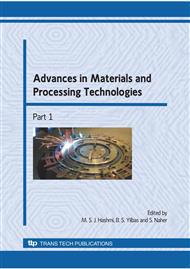[1]
H.K. Tönshoff, C. Arendt and R. Amor: Cutting of hardened steel, Annals of the CIRP, Vol. 49, n. 2 (2000), pp.547-66.
DOI: 10.1016/s0007-8506(07)63455-6
Google Scholar
[2]
C.H.D. Almeida and A.M. Abrao: Dimensional and geometric tolerances after machining case hardened AISI 5115 steel, International Journal for Manufacturing Science and Technology, Vol. 3, n. 2 (2001), pp.92-108.
Google Scholar
[3]
A. M. Abrao: Torneamento de aços endurecidos, in: Tecnologias Avançadas de Manufatura, Chap. 5, Edited by J. F. G. Oliveira / IFM , Editora Novos Talentos Pub., (2005), pp.89-103.
Google Scholar
[4]
B. Griffiths: Manufacturing Surface Technology, Penton Press, London, UK, (2001), p.233.
Google Scholar
[5]
S. Mittal and C.R. Liu: A method of modeling residual stresses in superfinish hard turning, Wear, Vol. 218, (1998), pp.21-33.
DOI: 10.1016/s0043-1648(98)00201-4
Google Scholar
[6]
J.D. Thiele, S.N. Melkote, R.A. Pascoe and T.R. Walkins: Effect of cutting-edge geometry and workpiece hardness on surface residual stresses in finish hard turning of AISI 52100 steel. Transactions of the ASME - Journal of Manufacturing Science and Engineering, Vol. 122, n. 4, (2000).
DOI: 10.1115/imece1999-0743
Google Scholar
[7]
Y. K. Chou and C. Evans: White layers and thermal modeling of hard turned surfaces, International Journal of Machine and Manufacture, Vol. 39, (1999), pp.1863-81.
DOI: 10.1016/s0890-6955(99)00036-x
Google Scholar
[8]
A. Ramesh and S. N. Melkote: White Layer Formation in Machining of Hardened Steel: Experiments and Modeling. In: High Speed Machining of Hard/Super Hard Materials, Sponsored by JSME, Japan and National University of Singapore, Singapore, November 7-11, (2003).
Google Scholar
[9]
W. König, M. Klinger and R. Link: Machining hard materials with geometrically defined cutting edges - Field of applications and limitations, Annals of the CIRP, Vol. 39, n. 1, (1990), pp.61-4.
DOI: 10.1016/s0007-8506(07)61003-8
Google Scholar


